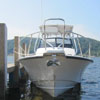|
Drain tube corrosion
|
| wannabe |
Posted on 06/24/09 - 7:24 PM
|
Member
Posts: 287
Comments:
1
Joined: 06/03/09
|
Do the corrosion of the tubes happen to both fresh water and salt boats ? My guess the salt would speed up the process.
Thanks,
Drew
|
| |
|
|
| Jeff |
Posted on 06/24/09 - 7:45 PM
|

Member
Posts: 1987
Comments:
34
Joined: 04/02/05
|
They deteriorate in both environments but, salt does speed the process. I replaced the tubes for the first time on my trailer kept Newport last year and though there were no holes the walls were paper thin. My 1975 13 Sport did have a failure on it I found went I replaced that tube for the first time this year. Both boats are 100% stored out of the water when not in use and have never seen salt.
1993 23' Walkaround Whaler Drive |
| |
|
|
| brooks89 |
Posted on 06/25/09 - 6:14 AM
|
Member
Posts: 177
Comments:
0
Joined: 05/24/07
|
Anyone have a guesstimate as to how long the brass tubes last? When I bought the boat about 7 or 8 years ago I had to replace the bilge drain tube which was pretty much shot. The boat is kept in salt water seasonally from May to October...
|
| |
|
|
| modenacart |
Posted on 06/25/09 - 5:36 PM
|
Member
Personal Page
Posts: 741
Comments:
4
Joined: 02/28/09
|
I think mine lasted about 30 years.
|
| |
|
|
| MW |
Posted on 06/26/09 - 12:07 AM
|
Member
Personal Page
Posts: 1827
Comments:
10
Joined: 01/08/06
|
Mine was badly corroded, I replaced with "PVC", I showed a co-worker how badly it deteriorated, and said that "I didn't think Brass fell apart that quickly", he said "It does'nt, what you pulled out of that hull is a 1" piece of common copper home heating pipe" (Thank's, previous owner).
Matt |
| |
|
|
| Paulsv |
Posted on 06/26/09 - 7:50 AM
|

Member
Personal Page
Posts: 122
Comments:
0
Joined: 08/27/07
|
I have started putting a drain plug on both ends of the drain tube, just to be safe and hopefully avoid corrosion. Any reason not to do this?
|
| |
|
|
| Tom W Clark |
Posted on 06/26/09 - 8:15 AM
|

Member
Personal Page
Posts: 4280
Comments:
7
Joined: 09/30/05
|
I would NEVER plug the outside of a drain tube. You may need to drain your boat in a hurry some day and you cannot reach the outboard ends of the drain tubes form inside the boat, at least not on anything but very small Whalers.
My 20 year old, saltwater use only Whaler still has intact drain tubes. I have replaced the transom tubes and found the originals were fine.
It is not a complicated chore to replace the brass drain tubes. I recommend it to any Whaler owner so they know that what they have is sound.
The plastic or PVC idea has its own set of problems I choose not to deal with.
|
| |
|
|
| Seafarer |
Posted on 06/29/09 - 1:13 PM
|

Member
Personal Page
Posts: 25
Comments:
0
Joined: 04/15/09
|
Tom W Clark wrote:
I would NEVER plug the outside of a drain tube. You may need to drain your boat in a hurry some day and you cannot reach the outboard ends of the drain tubes form inside the boat, at least not on anything but very small Whalers.
My 20 year old, saltwater use only Whaler still has intact drain tubes. I have replaced the transom tubes and found the originals were fine.
It is not a complicated chore to replace the brass drain tubes. I recommend it to any Whaler owner so they know that what they have is sound.
The plastic or PVC idea has its own set of problems I choose not to deal with.
I have to replace my '86 Montauk's bilge tube (the tube is in fine shape, but the ring/lip at the transom came off with the plug). I opened up the bilge cover to see about using the plug at the top of the tube, and it's absolutely buried under all the rigging - bilge pump, engine electric, steering, transducer wiring, stern light wiring, etc.
It would be far faster to hang off the transom at low speed or a stop to pull the plug than to fish down through all the stuff in the bilge in order to uncork.
What do you think about using a quick release plug with a string tied off to, say, the aft railing as an emergency pull?
Edited by Seafarer on 06/29/09 - 1:14 PM |
| |
|
|
| Joe Kriz |
Posted on 06/29/09 - 1:17 PM
|

Site Owner
Personal Page
Personal Album
Photo Albums
Project Albums
Posts: 11434
Comments:
452
Joined: 03/18/05
|
Seafarer,
I would be more concerned about putting a string on the person hanging over the back to remove the plug. Matter of fact, I would tie about 50 yards of 300 pound test and troll with the person... You never know what you might catch...
Tip: I would straighten up the rigging tunnel so the plug could be accessed easier.
|
| |
|
|
| Guts |
Posted on 06/29/09 - 2:21 PM
|

Member
Personal Page
Posts: 612
Comments:
8
Joined: 11/21/08
|
I went the PVC way on the thru hull drains, I didn't want to replace them because of corrosion... One thing I learned when I worked on commercial fishing boats. When tied up at the dock, and there were steel boats around. where welding was taking place the zinc's world be gone in one season. Normally there would be some left when we haled, to survey the boat.
Please! Do Not take this wrong.. I am just stating the fact I have a lot of stuff in a little space.
I have two hydraulic lines , engine wiring, bilge pump, plus a large thru hull transducer, and a transom mounted transducer plus wires(two) with a plug inside. There is room for he plug on the inside of a Montauk ...
|
| |
|
|
| Binkie |
Posted on 06/29/09 - 7:13 PM
|

Member
Personal Page
Posts: 2012
Comments:
0
Joined: 12/19/05
|
Tom`s quote: The plastic or PVC idea has its own set of problems I choose not to deal with.
I have no idea what those problems could be. Apparently I have overcome them a few times without realizing it.
Rich |
| |
|
|
| RevengeFamily |
Posted on 06/30/09 - 4:11 AM
|

Member
Personal Page
Posts: 192
Comments:
2
Joined: 06/21/08
|
Just this past weekend I installed a drain tube into the "fishwell" on my 1990 Revenge. I got tired of needing to pump this space dry.
I used PVC, Angled the tube toward the stern to facilitate water removal while underway. No need for a clam shell. I don't plan on replacing any of the thru hulls with bronze tubing. Why chase my tail a few years down the road. Do the job once and be done.
|
| |
|
|
| HarleyFXDL |
Posted on 06/30/09 - 8:02 AM
|
Member
Personal Page
Project Albums
Posts: 917
Comments:
30
Joined: 07/24/07
|
I used sraab 928's idea when replacing my tubes. I first cut PVC and epoxied it into the drain tube hole. Then I put a brass tube on the inside of the PVC and flared it. If the brass ever leaks, the PVS will prevent water from entering the transom. Looks great and you can't tell there is PVC behind the brass.
Kevin
1988 11' Super Sport, 1987 Johnson 15hp.
If you think education is expensive, try ignorance
"Vegetarian - old Indian word for bad fisherman." |
| |
|
|
| Tom W Clark |
Posted on 06/30/09 - 9:14 AM
|

Member
Personal Page
Posts: 4280
Comments:
7
Joined: 09/30/05
|
Plastic does not corrode but it does shrink and become brittle with age. Get back to us in a decade or two and let us know how those plastic drain tubes are holding up.
It should be noted that when discussing plastic drain tubes, there are two distinctly different approaches:
- PVC drain pipe finished flush with the hull, which Whaler used themselves for the anchor lockers on some larger models as drains (but NEVER below the waterline).
- Preformed flanged plastic drains tubes in two pieces that snap together. Whaler uses these now at the factory.
If using the former technique, you either use drain pipe that has a 3/4" id, instead of 1", thus restricting your draining capacity by 45 percent - OR - you have to drill a larger hole in your hull to accommodate the much great diameter of 1" id pipe. Once you've drilled that hole in your hull, there is never any going back, you're stuck with it.
Furthermore, there are drain tubes on many Whalers where the tube is placed very close to an adjacent surface. Enlarging the hole would put the edge of the hole on a different plane where it cannot be finished cleanly. Indeed I have seem drains in the rigging tunnels of Montauks so far down that if you enlarged the holes at all, you would be cutting into the bottom of the tunnel.
Even if the hole for the tube comes out on a flat surface on both sides of the hull, gluing in a PVC pipe relies entirely upon the glue joint between the pipe itself and the edge of the fiberglass hull skin which is only 1/8" - 1/4" wide on most Whaler hulls. Coating the entire tube with epoxy or polyurethane caulk does nothing but make it difficult or impossible to replace the tube in the future. Gluing it to the foam does nothing to prevent water intrusion because once there is a gap between the pipe and the fiberglas, water can get in behind the glued surface of the tube where it is glued to the foam.
The preformed flange can help solve that problem by providing a good overlap of drain and hull, but then you have to deal with several other problems.
The preformed flange is formed perpendicular to the tube itself. This is great if the hole in your hull for the drain tube is perpendicular to the hull's surfaces. The problem is that is very rarely the case. Even the simplest situation, a splashwell drain tube going through the transom, is often not drilled square. Try a drain tube on a bow locker on a 22 or the stern sump in an 11 footer. No way is it going to be easy.
The bow sump in the 22s are perhaps the worst of all. The drain tubes emerge out of that hull at an angle of over 20 degrees. There is no way the pre-formed flange will meet the hull cleanly.
Andy Gere has some personal experience on his Outrage Cuddy 22 with the pre-formed drain tubes he bought from a Whaler dealer. He had to first drill the hull larger to accommodate the plastic, and then tried the get the plastic to bend to accommodate the shape of his hull. The results were not satisfactory.
I helped Andy replace the rest of his drain tubes with brass and O-ring tubes. We would have redone the plastic one except because he drilled out the hull, there was no going back; it had to stay.
If you try to use a preformed tube in a spot where the hole in the hull is driller near an adjacent surface, the flange gets in the way. I saw a newer Sport 130 at my outboard mechanic's shop that had the factory installed plastic drain tube in the stern. The hole was drilled very near the floor and because of this, the flange interfered with it drawing up tight against the hull. It was left about 3/8" out with no visible caulk to fill the void. It was just unbelievably bad.
But let's say you get lucky and have a spot where the drain tube hole is perpendicular to the hull and you can get the flange to lay flat against it. That will work, right? Not if it is in a spot where it needs to be protected by a clam shell.
Because the flange on the plastic drain tubes is so much larger, the standard Perko 2" x 2" clam shell ventilator that Whaler used will not fit. Oh sure, you could swap it out for a much larger one, but then you are drilling five new screw hole sin the bottom of your hull and filling the five old screw holes too. You end up with a massive clam shell with added drag and greater venerability of being crushed by your trailer. No thanks.
By using the brass drain tubes with O-rings and caulk, you can make the flange fit in very tight spaces and conform to irregular shapes and angles. They are inexpensive easy to replace and maintain full water flow for quick draining. Yes, I concede the use of a PVC drain tube or even a poorly fitting preformed drain tube may be fine for a small cream-puff Whaler that is dusted off and brought out of the carport for the occasional run around the lake, it is certainly not going to be satisfactory for larger Whalers that live in the water and get used hard as mine does.
Edited by Tom W Clark on 06/30/09 - 10:13 AM |
| |
|
|
| Guts |
Posted on 06/30/09 - 11:04 AM
|

Member
Personal Page
Posts: 612
Comments:
8
Joined: 11/21/08
|
Tom I will answer one of your questions [(Plastic does not corrode but it does shrink and become brittle with age. Get back to us in a decade or two and let us know how those plastic drain tubes are holding up.)]
I put mine in 1996,(like these) http://whalercentral.com/articles.php?article_id=94 and they are as good as when I put them in. Maybe this depends on where you live.
ADDED:
As I have said before If some one was to do a full restoration on a classic you might want to go with original equipment...
Edited by Guts on 06/30/09 - 2:01 PM |
| |
|
|
| RevengeFamily |
Posted on 06/30/09 - 1:08 PM
|

Member
Personal Page
Posts: 192
Comments:
2
Joined: 06/21/08
|
Tom,
I had to replace pilings for a friends dock 20 years ago. The wood pilings were just getting demolished by worms.We decided to install 20 foot lengths of 8" and 10" schedule 40 as the pilings. They have been submerge in a salt water environment ever since. They have not been touch by UV rays, water, ice or any marine creatures, Oh and they don't harm the ecosytem like treated pilings do. I have every confidence in my new PVC thru hulls.
Norm
|
| |
|
|
| HarleyFXDL |
Posted on 06/30/09 - 1:59 PM
|
Member
Personal Page
Project Albums
Posts: 917
Comments:
30
Joined: 07/24/07
|
All new homes use PVC for plumbing. The use of copper in new homes, at least in Delaware, is no longer used. If plastic shrinks and becomes brittle, I would say every new home in Delaware will accomodate NEW indoor swimming pools in a decade or so.
Kevin
1988 11' Super Sport, 1987 Johnson 15hp.
If you think education is expensive, try ignorance
"Vegetarian - old Indian word for bad fisherman." |
| |
|
|
| Guts |
Posted on 06/30/09 - 2:10 PM
|

Member
Personal Page
Posts: 612
Comments:
8
Joined: 11/21/08
|
HarleyFXDL
The PVC tubes that are sold from BW feel different than PVC used in swimming pool pipe,I have a in ground pool. I believe it might be a different compound of plastic. I have some in the shop, the ones that are pictured in the Article section...
http://whalercentral.com/articles.php...icle_id=94
Edited by Joe Kriz on 06/30/09 - 3:49 PM |
| |
|



